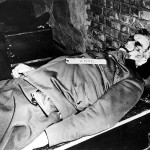The manuscript for the walking tour of medieval Paris is in the hands of my editor. This means I can turn my full attention to researching and writing the book, Where Did They Put the Gestapo Headquarters? – A Walking Tour of Nazi Occupied Paris 1940–1944. I actually started writing the book’s introduction in February but have now begun the full-on research to determine the actual stops I’ll take you to. This has become a very different experience compared to the prior 3 books. Perhaps those themes were so far removed from a time perspective that the impact on me wasn’t as dramatic. Somehow the stories and brutality of the French Revolution and Middle Ages never affected me in a way the Nazi efforts to eradicate millions and millions of people have (and it wasn’t just the Jews that were targeted for extermination). Remember, it was only a short 75-years ago that the Germans marched down the Champ Élysées to begin their 4-year occupation of Paris.
It doesn’t matter which stop I’m researching, each has a story with an ending that makes me extremely sad. Frankly, in some cases I’ve had trouble sleeping thinking about a particular story and the people involved. So when I come across a story with a happy ending, I want to embrace it and share it with my friends. This particular story caught my attention because of the BBC headlines announcing the death on July 1, 2015 of a 106-year-old gentleman by the name of Sir Nicholas Winton (1909–2015).
Night of the Broken Glass
Shortly after Kristallnacht took place in Germany in November 1938, Mr. Winton traveled to Prague to assist in Jewish welfare work. He set up an organization to get Jewish children under the age of 17 out of Poland and resettle them with British families in England. He and others could see into the near future and the likely fate of Polish Jews. Britain had set up a program whereby they would allow refugees under the age of 17 to come to England provided they could prove they had a place to stay and £50 was deposited into a bank account assuring they could get back to Poland. Read More Kindertransport and Mr. Winton


